[English] 日本語
 Yorodumi
Yorodumi- PDB-5tpz: Crystal structure of amino terminal domains of the NMDA receptor ... -
+ Open data
Open data
- Basic information
Basic information
| Entry | Database: PDB / ID: 5tpz | |||||||||
|---|---|---|---|---|---|---|---|---|---|---|
| Title | Crystal structure of amino terminal domains of the NMDA receptor subunit GluN1 and GluN2B in apo closed state | |||||||||
 Components Components |
| |||||||||
 Keywords Keywords | TRANSPORT PROTEIN / ION CHANNEL / NMDA RECEPTOR / ALLOSTERIC MODULATION | |||||||||
| Function / homology |  Function and homology information Function and homology informationcellular response to curcumin / cellular response to corticosterone stimulus / cellular response to magnesium starvation / sensory organ development / sensitization / EPHB-mediated forward signaling / Assembly and cell surface presentation of NMDA receptors / response to hydrogen sulfide / auditory behavior / dendritic branch ...cellular response to curcumin / cellular response to corticosterone stimulus / cellular response to magnesium starvation / sensory organ development / sensitization / EPHB-mediated forward signaling / Assembly and cell surface presentation of NMDA receptors / response to hydrogen sulfide / auditory behavior / dendritic branch / response to other organism / regulation of ARF protein signal transduction / fear response / apical dendrite / positive regulation of inhibitory postsynaptic potential / suckling behavior / response to methylmercury / response to manganese ion / response to carbohydrate / interleukin-1 receptor binding / cellular response to dsRNA / response to growth hormone / cellular response to lipid / negative regulation of dendritic spine maintenance / heterocyclic compound binding / positive regulation of glutamate secretion / regulation of monoatomic cation transmembrane transport / RAF/MAP kinase cascade / NMDA glutamate receptor activity / Synaptic adhesion-like molecules / response to glycoside / NMDA selective glutamate receptor complex / glutamate binding / ligand-gated sodium channel activity / response to zinc ion / calcium ion transmembrane import into cytosol / protein heterotetramerization / glycine binding / response to amine / regulation of cAMP/PKA signal transduction / receptor clustering / small molecule binding / startle response / monoatomic cation transmembrane transport / parallel fiber to Purkinje cell synapse / behavioral response to pain / regulation of MAPK cascade / associative learning / regulation of postsynaptic membrane potential / action potential / extracellularly glutamate-gated ion channel activity / response to magnesium ion / response to electrical stimulus / monoatomic cation transport / regulation of neuronal synaptic plasticity / glutamate receptor binding / Unblocking of NMDA receptors, glutamate binding and activation / positive regulation of excitatory postsynaptic potential / long-term memory / detection of mechanical stimulus involved in sensory perception of pain / response to mechanical stimulus / synaptic cleft / neuron development / positive regulation of synaptic transmission, glutamatergic / behavioral fear response / multicellular organismal response to stress / postsynaptic density, intracellular component / monoatomic cation channel activity / response to fungicide / glutamate-gated receptor activity / cell adhesion molecule binding / regulation of long-term synaptic depression / cellular response to manganese ion / D2 dopamine receptor binding / glutamate-gated calcium ion channel activity / presynaptic active zone membrane / response to cytokine / ionotropic glutamate receptor binding / ligand-gated monoatomic ion channel activity involved in regulation of presynaptic membrane potential / ionotropic glutamate receptor signaling pathway / cellular response to forskolin / sodium ion transmembrane transport / protein tyrosine kinase binding / synaptic membrane / response to amphetamine / hippocampal mossy fiber to CA3 synapse / learning / response to nicotine / response to cocaine / regulation of membrane potential / excitatory postsynaptic potential / transmitter-gated monoatomic ion channel activity involved in regulation of postsynaptic membrane potential / synaptic transmission, glutamatergic / hippocampus development / cellular response to amino acid stimulus / regulation of long-term neuronal synaptic plasticity / postsynaptic density membrane / response to calcium ion / cerebral cortex development / beta-catenin binding Similarity search - Function | |||||||||
| Biological species |  | |||||||||
| Method |  X-RAY DIFFRACTION / X-RAY DIFFRACTION /  SYNCHROTRON / SYNCHROTRON /  MOLECULAR REPLACEMENT / Resolution: 3.095 Å MOLECULAR REPLACEMENT / Resolution: 3.095 Å | |||||||||
 Authors Authors | Romero-Hernandez, A. / Simorwski, N. / Karakas, E. / Furukawa, H. | |||||||||
| Funding support |  United States, 2items United States, 2items
| |||||||||
 Citation Citation |  Journal: Neuron / Year: 2016 Journal: Neuron / Year: 2016Title: Molecular Basis for Subtype Specificity and High-Affinity Zinc Inhibition in the GluN1-GluN2A NMDA Receptor Amino-Terminal Domain. Authors: Romero-Hernandez, A. / Simorowski, N. / Karakas, E. / Furukawa, H. | |||||||||
| History |
|
- Structure visualization
Structure visualization
| Structure viewer | Molecule:  Molmil Molmil Jmol/JSmol Jmol/JSmol |
|---|
- Downloads & links
Downloads & links
- Download
Download
| PDBx/mmCIF format |  5tpz.cif.gz 5tpz.cif.gz | 148.4 KB | Display |  PDBx/mmCIF format PDBx/mmCIF format |
|---|---|---|---|---|
| PDB format |  pdb5tpz.ent.gz pdb5tpz.ent.gz | 108 KB | Display |  PDB format PDB format |
| PDBx/mmJSON format |  5tpz.json.gz 5tpz.json.gz | Tree view |  PDBx/mmJSON format PDBx/mmJSON format | |
| Others |  Other downloads Other downloads |
-Validation report
| Summary document |  5tpz_validation.pdf.gz 5tpz_validation.pdf.gz | 468.7 KB | Display |  wwPDB validaton report wwPDB validaton report |
|---|---|---|---|---|
| Full document |  5tpz_full_validation.pdf.gz 5tpz_full_validation.pdf.gz | 482.2 KB | Display | |
| Data in XML |  5tpz_validation.xml.gz 5tpz_validation.xml.gz | 26.7 KB | Display | |
| Data in CIF |  5tpz_validation.cif.gz 5tpz_validation.cif.gz | 36.3 KB | Display | |
| Arichive directory |  https://data.pdbj.org/pub/pdb/validation_reports/tp/5tpz https://data.pdbj.org/pub/pdb/validation_reports/tp/5tpz ftp://data.pdbj.org/pub/pdb/validation_reports/tp/5tpz ftp://data.pdbj.org/pub/pdb/validation_reports/tp/5tpz | HTTPS FTP |
-Related structure data
| Related structure data | 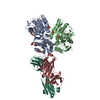 5tpwC 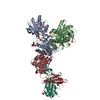 5tq0C  5tq2C 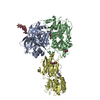 3qelS S: Starting model for refinement C: citing same article ( |
|---|---|
| Similar structure data |
- Links
Links
- Assembly
Assembly
| Deposited unit | 
| ||||||||
|---|---|---|---|---|---|---|---|---|---|
| 1 |
| ||||||||
| Unit cell |
| ||||||||
| Components on special symmetry positions |
|
- Components
Components
| #1: Protein | Mass: 42932.055 Da / Num. of mol.: 1 / Fragment: residues 23-405 Source method: isolated from a genetically manipulated source Source: (gene. exp.)  Trichoplusia ni (cabbage looper) / References: UniProt: Q91977, UniProt: A0A1L8F5J9*PLUS Trichoplusia ni (cabbage looper) / References: UniProt: Q91977, UniProt: A0A1L8F5J9*PLUS | ||||
|---|---|---|---|---|---|
| #2: Protein | Mass: 41149.625 Da / Num. of mol.: 1 / Fragment: residues 32-393 Source method: isolated from a genetically manipulated source Source: (gene. exp.)   Trichoplusia ni (cabbage looper) / References: UniProt: Q00960 Trichoplusia ni (cabbage looper) / References: UniProt: Q00960 | ||||
| #3: Sugar | ChemComp-NAG / #4: Water | ChemComp-HOH / | Has protein modification | Y | |
-Experimental details
-Experiment
| Experiment | Method:  X-RAY DIFFRACTION / Number of used crystals: 1 X-RAY DIFFRACTION / Number of used crystals: 1 |
|---|
- Sample preparation
Sample preparation
| Crystal | Density Matthews: 2.7 Å3/Da / Density % sol: 54.51 % |
|---|---|
| Crystal grow | Temperature: 291 K / Method: vapor diffusion, hanging drop / pH: 5 Details: 20% PEG 3350, 1.4M Sodium formate, 0.3M Sodium thyocyanate, 0.1M sodium acetate pH 5.0 |
-Data collection
| Diffraction | Mean temperature: 100 K |
|---|---|
| Diffraction source | Source:  SYNCHROTRON / Site: SYNCHROTRON / Site:  NSLS NSLS  / Beamline: X25 / Wavelength: 1 Å / Beamline: X25 / Wavelength: 1 Å |
| Detector | Type: ADSC QUANTUM 315 / Detector: CCD / Date: Jun 12, 2010 |
| Radiation | Protocol: SINGLE WAVELENGTH / Monochromatic (M) / Laue (L): M / Scattering type: x-ray |
| Radiation wavelength | Wavelength: 1 Å / Relative weight: 1 |
| Reflection | Resolution: 3.09→37.891 Å / Num. obs: 18198 / % possible obs: 98.6 % / Redundancy: 5.2 % / Rmerge(I) obs: 0.093 / Net I/σ(I): 13 |
- Processing
Processing
| Software |
| ||||||||||||||||||||||||||||||||||||||||||||||||||||||||
|---|---|---|---|---|---|---|---|---|---|---|---|---|---|---|---|---|---|---|---|---|---|---|---|---|---|---|---|---|---|---|---|---|---|---|---|---|---|---|---|---|---|---|---|---|---|---|---|---|---|---|---|---|---|---|---|---|---|
| Refinement | Method to determine structure:  MOLECULAR REPLACEMENT MOLECULAR REPLACEMENTStarting model: 3QEL Resolution: 3.095→37.891 Å / SU ML: 0.5 / Cross valid method: FREE R-VALUE / σ(F): 1.34 / Phase error: 33.42
| ||||||||||||||||||||||||||||||||||||||||||||||||||||||||
| Solvent computation | Shrinkage radii: 0.9 Å / VDW probe radii: 1.11 Å | ||||||||||||||||||||||||||||||||||||||||||||||||||||||||
| Displacement parameters | Biso max: 149.19 Å2 / Biso mean: 86.3075 Å2 / Biso min: 48.34 Å2 | ||||||||||||||||||||||||||||||||||||||||||||||||||||||||
| Refinement step | Cycle: final / Resolution: 3.095→37.891 Å
| ||||||||||||||||||||||||||||||||||||||||||||||||||||||||
| Refine LS restraints |
| ||||||||||||||||||||||||||||||||||||||||||||||||||||||||
| LS refinement shell | Refine-ID: X-RAY DIFFRACTION / Total num. of bins used: 7
|
 Movie
Movie Controller
Controller


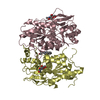
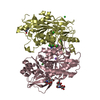
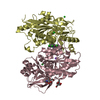

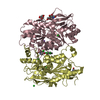
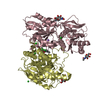
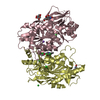
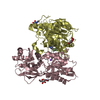
 PDBj
PDBj






